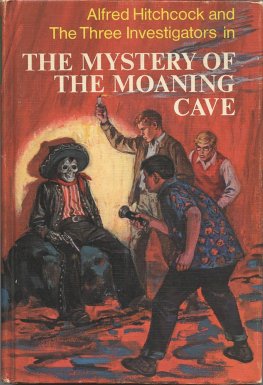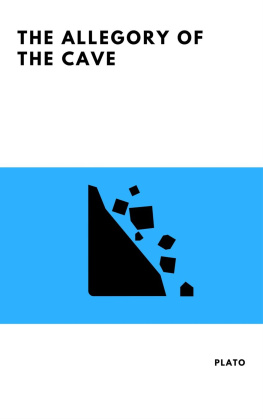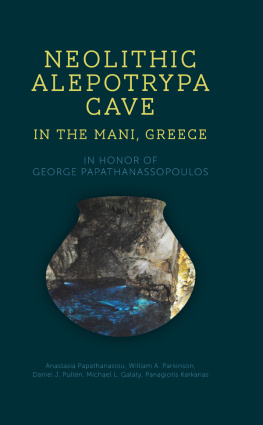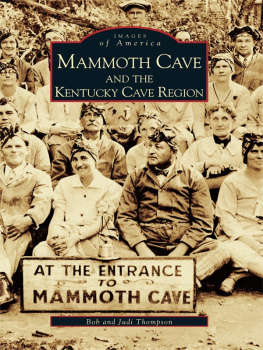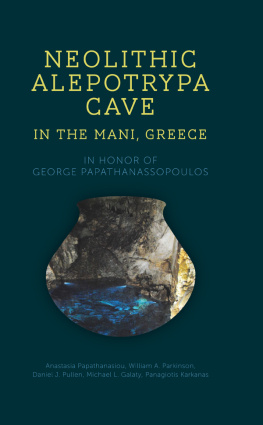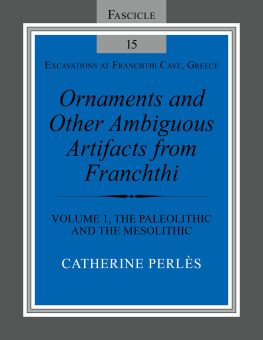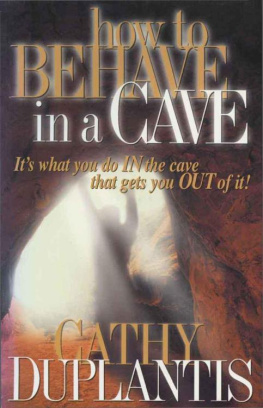Copyright 2000 by William R. Farrand
All rights reserved
No part of this book may be reproduced or utilized in any form or by any means, electronic or mechanical, including photocopying and recording, or by any information storage and retrieval system, without permission in writing from the publisher. The Association of American University Presses Resolution on Permission constitutes the only exception to this prohibition.
This book has been supported by a grant from the National Endowment for the Humanities, an independent federal agency
Cataloging-in-Publication Data
Farrand, William R.
Depositional History of the Franchthi CaveStratigraphy, Sedimentology, and Chronology /
William R. Farrand, with a report on the
background of the Franchthi Project by
Thomas W. Jacobson.
(Excavations at Franchthi Cave, Greece; fasc. 12)
References: p.
1. Franchthi Cave Site (Greece). 2. Stone AgeGreece.
3. Excavations (Archaeology)Greece. 4. GreeceAntiquities.
I. Farrand, William R. II. Title. III. Series
ISBN 0-253-21314-2
1 2 3 4 5 04 03 02 01 00 99
PREFACE AND ACKNOWLEDGMENTS
It has been a long road since the day in summer 1974 when I agreed to take on the study of the sediments in Franchthi Cave. Tom Jacobsen invited me to the site because I had made similar studies on a number of prehistoric cave sites in the Near East and France. On my brief visit in 1974, I quickly realized that Franchthi was a very interesting cave with considerable time depth. It presented me with some challenges and opportunities that I had not experienced previously. I agreed on the spot to return for the next seasonin 1976to sample the sediments. The 1976 season was to be the final digging season in Franchthi. All the trenches inside the cave were still open, although some were somewhat slumped or not very clean. The disadvantage of joining the project so late, of course, was not being at the site during the preceding seven seasons, during which much sediment was removed. This meant that I had to rely on field notebook descriptions and drawings of sections long disappeared by excavators who were no longer associated with the project.
So in 1976 the sediments were sampled selectively; all the sections were examined, as well as the surrounding landscape. I returned during the study season in 1979 to work with the project draftsman, Dan Pullen, on the preparation of the final section drawings and plans. We compared all the extant sections against the drawings that had been made over the eight years of field work. It turned out that my background in geology, and in cave stratigraphy in particular, earned me the de facto assignment of cave stratigrapher for the project. This was not a job that I had counted on, but it is one of prime importance on any stratified site. It was a great opportunity for me, for which I am grateful, not only concerning Franchthi, but in theoretical terms as well.
It is important to say that this fascicle does not stand by itself. There are many cross-references herein to the contributions of my Franchthi colleagues, to which the reader should refer for elaboration of their ideas and their data.
The project team had two fruitful opportunities to meet together for symposia in Bloomington, Indiana, to discuss various aspects of phasing and overall stratigraphy (more details in ). Then, I was able to spend the Fall of 1985 in Bloomington studying the notebooks and drawings. Unfortunately I was sidetracked by academic duties thereafter, and Franchthi was put on the shelf until recently.
My initial approach to the sediment study was somewhat circumscribed because I was coming to the project belatedly. However, once I became concerned with the stratigraphy and correlations in the cave, and with deciphering the notebooks, I wished that I had sampled more extensively and in all the cave trenches. It was too late at that point because the excavations were shut down. In any case, the excavation documents contained a great amount of information, and increasingly so as the excavation seasons proceeded. Nevertheless, some questions can never be completely answered from the available information.
I am very grateful to all my Franchthi colleagues for helping me to understand their work and all that had transpired before I arrived on the scene. Tom Jacobsen, of course, made this all possible with his foresight in bringing me into a well-organized, interdisciplinary project. His approach to a complex site such as Franchthi was exemplary, and he did a great job as master of ceremonies. His close and valued friendship is one of my most appreciated rewards from working at Franchthi. In addition, Tom has contributed valuable historical information on the site and on the project in general in the first and second chapters of this fascicle.
Kaddee Vitellis leadership in these past few years has been a great boon, especially in seeing us through the publication stage. Moreover, she and I continue to have interesting discussions on stratigraphic matters. Catherine Perls also has helped keep me honest in my interpretations and extrapolations. Tony Wilkinson showed me the landscape and shared his ideas on the geomorphology of the area around Franchthi during my first visit in 1974, and I greatly appreciate his insights into aspects of the cave stratigraphy, as well. Tjeerd van Andel has also become a valued colleague over the course of these years, and he and Julie Stein have been very helpful in reviewing the earlier version of this fascicle and in making very useful suggestions for improving it. Julie Hansen and I have worked closely on questions of stratigraphy, particularly biozonation. Nancy Whitney-Desautels study of land snails has contributed very interesting, serendipitous data for interpreting the Franchthi depositional history, and she and I worked closely on approaches to land-snail biozonation for, I hope, our mutual benefit. Susan Duhon spent some time in Ann Arbor voluntarily helping with the laboratory analyses, along with Larry Davis, one of my Michigan masters degree students.
Kay Clahassey, artist in the University of Michigan Museum of Anthropology, has done a magnificent job and shown much patience in translating my rough drawings into handsome figures.
Finally, I am deeply indebted to Carola and Michelle, not only for their forbearance, but also for their encouragement while I have been working too long and too hard on completing this work.
Financial support for my Franchthi research has come through various grants to T. W Jacobsen and to K. D. Vitelli through the Program in Classical Archaeology at Indiana University. I am also grateful to the Indiana University Institute for Advanced Studies for a fellowship during my research leave in Bloomington in 1985.
Depositional History of Franchthi Cave

